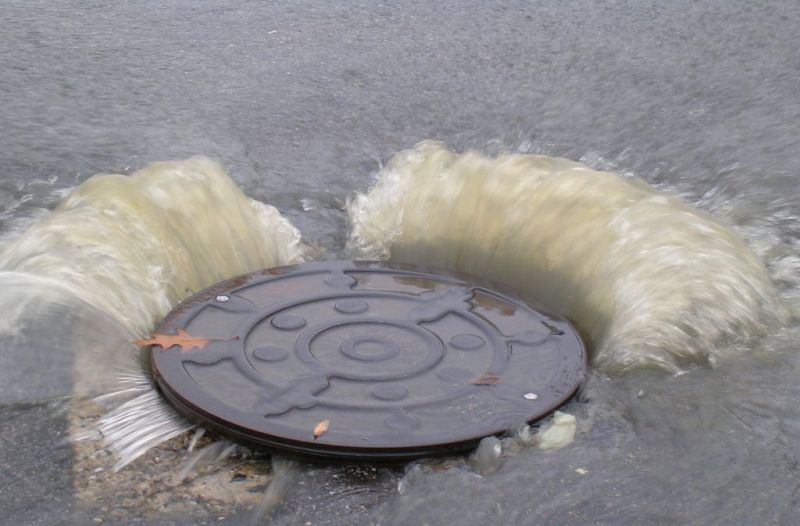Close up of a plumbing sewer overflow. Photo: Lawrence Cahoon / UNCW
This is the ninth in an on-going series on Climate Change and the North Carolina Coast that is part of the Pulitzer Center’s Connected Coastlines nationwide reporting initiative.
One of the most disgusting things about cleaning up after the storm is wading through stinking water filled with raw sewage.
This emergency does not only apply to recovery after the hurricane – faecal pathogens in leaks and spills now often pollute rainwater after heavy rains.
Climate change is coming to our backyard septic tanks and ultimately to our municipal waste treatment systems.
“In the long run, sea level rise will exceed all of that,” said Lawrence Cahoon, professor of biology and researcher at the University of North Carolina, Wilmington, in a recent interview. “I think if we live on the coast for long periods of time, the sewer systems will fail us and the sewer systems will fail. They are already. “

Lawrence Cahoon
Septic tanks are widely used in coastal North Carolina to eliminate human waste, our humble by-product and disease vector. However, higher groundwater, more rainfall, and epic floods from intense storms have caused systems to leak or become inoperable.
These same climate forces are also at risk of jeopardizing the aged and deteriorating municipal sewage systems that primarily serve urban communities.
“The solution is to fix the system,” said Cahoon. “In general, the problem is that people don’t want to spend the money on it.”
Public sewage treatment costs are usually borne by the local government, which covers the costs through borrowings and connection fees to the property owner. Some governments, such as Brunswick County’s, have water and sewer systems that are operated by a separate agency.
In rural Tyrrell County, a northeastern county with a high poverty rate, septic tanks had failed in wetland-dominated communities for years. Thanks to a grant from the state trust fund for clean water management, about 65% of the county’s communities have been hooked up to a complex sewer system that has a pump and tank on every property, said district manager David Clegg.
The district completed this first phase of construction in the early 2000s. A second phase was completed in 2011 and a third phase in 2018. The next phase is in the planning phase and the district officials are looking for funding.
Since gravity systems are not an option, the waste has to be pumped for miles to a sewage treatment plant. So far, the system has cost about $ 20 million and will take about $ 10 million more to complete, Clegg said.
Tyrrell, one of the most economically troubled counties in the state, could never afford such an expensive system without help. However, sewage treatment plants are also a tax challenge for wealthier communities.
“Central sewer is terribly expensive,” said Cahoon, “and if something goes wrong you can’t afford to fix it.”
Older infrastructure typically includes cast iron pipes that tend to corrode, he said. As long as the joints are flawless, sewage pipes made of PVC are durable and reliable.
However, upgrades to corrosive systems can be costly and a full replacement would be even more important.
“There isn’t enough money in the world to do this,” said Cahoon.
Together with Marc Hanke of the Honors College at the University of Houston, Cahoon studied the effects of infiltration and infiltration (I&I) on sewage treatment plants. Inflow is water that comes from the ground, such as B. a manhole. Infiltration is groundwater that seeps through cracks like cracks in pipes.
One impetus for research is the lack of understanding of the effects of a higher mean sea level on the systems: How much salt water has penetrated? What happens to tidal influences? What effects do heavy rain and higher groundwater levels have on flow and capacity?
According to the study published in Water Science & Technology in 2017, I&I can cause system overflows and system degradation and affect water quality. The study analyzed system flow responses to precipitation and temperature in 93 gravity collection wastewater treatment plants in eastern North Carolina.
Data on hurricanes were purposely not included.
“I wanted to know what was going on regularly,” said Cahoon.
Over two years, coastal water gauges and daily tides as well as data on rates of sea level rise, temperatures, and cumulative and daily rainfall were examined.
Since there is only a limited amount of design, even the newest plants are not immune to spills in large storms that overwhelm the system. For example, a 2-inch rainstorm can create about 40% additional flow.
“So if that 40% puts you beyond the capacity of the facility,” said Cahoon, “you will likely get buried, or mistreated, or both.”
State regulators recognize that the system design cannot accommodate large amounts of rain and that up to 1,000 gallons can be spilled before mandatory reporting occurs.
According to Cahoon, the owners’ pipes connected to the public system often need to be repaired or replaced.
“The average owner has no idea” about their condition, Cahoon said, adding, “The connecting pipes are probably half the system.”
The study found that heavy rainfall, temperatures – likely as the effects of seasonal fluctuations in groundwater levels – and sea levels, expressed as the highest tide of a day, had a significant impact on 90% of the wastewater treatment systems on the North Carolina coast.
“These collective results demonstrate the potential vulnerability of coastal wastewater collection and treatment systems to system integrity violations that allow extraneous currents, particularly from groundwater levels, to further deteriorate infrastructure and pollute the environment,” write Cahoon and Hank.
Last year, another research team started a study entitled “Inflection points in wastewater infrastructure: prioritizing the implementation of climate adaptation plans in decentralized systems”, which focus on septic tanks, including individual residential tanks and “packaging systems”, on-site wastewater treatment plants that serve or a group of properties in a neighborhood. Extreme rainfall and flooding at high tide as well as rising sea levels have endangered the function and effectiveness of sewage systems, especially on the coast, according to the summary.
The two-year study was funded by a grant of approximately $ 300,000 from the National Oceanic and Atmospheric Administration’s climate program office.
Working with the cities of Nags Head and Folly Beach, South Carolina, the research team from North Carolina State University, the North Carolina Sea Grant, East Carolina University, the South Carolina Sea Grant, the Coastal Studies Institute and the University of Georgia will work together Evaluation of existing decentralized or on-site wastewater treatment systems and future alternative technologies.
The project builds on previous research and will target experts in the septic tank industry.
Septic on the Outer Banks has been affected not only by the higher sea level rise on the northeast coast and its vulnerability to tropical storms, but also by exceptionally heavy rainstorms that have occurred in recent years.
As a result, there is a higher water table, said Michael O’Driscoll, associate professor in ECU’s Department of Coastal Studies.
O’Driscoll, who also works at the Coastal Studies Institute, said there should be at least 1½ feet of dry soil under a sewer system to allow proper drainage and distribution of nutrients. At least there is less space available now, especially in older systems.

Michael O’Driscoll
“Since the 1980s, Dare County has looked like the water table has risen a foot,” said O’Driscoll. “Some systems may have less soil to handle the waste, other systems may have higher groundwater.”
There is also a short-term effect from a major storm. An event that shed 7 inches of rain temporarily raised the water table by 4 feet.
It’s hard to say how long the systems will work, added O’Driscoll. But if it’s wet all the time, the septic tank will fail.
Researchers will review available waste treatment technologies, economic analysis, and regulatory requirements to help communities evaluate appropriate climate adaptation strategies. In addition, they developed survey and interview questions to gather input from industry operators and experts.
Interviews are also conducted with county health departments, which are only required to process the original government permit or to report on health concerns.
“This part of our project is really getting a better understanding of the records, permits, and monitoring,” said Jane Harrison, coastal economics specialist at North Carolina Sea Grant.
Two million households in North Carolina use septic tanks and more than one in five across the country, she said.
At the end of the project, Harrison said there will be a report with suggestions and hopefully a website that will provide public information.
It’s not a topic people are dying to learn about, Harrison said, but the public has been more interested in climate change. And they will soon understand the impact climate has on toilet flushing.

Jane Harrison
“Septic was kind of the missing piece of the puzzle,” she said.
Even so, climate change has become a problem on the east coast: Miami, Florida and Rhode Island have each conducted studies to solve the problem.
“When the population density gets high, the septic tanks just can’t work,” said Cahoon.
Before a central sewer was available in Brunswick County, Sunset Beach had up to 10 septic tanks an acre. The restaurants in Calabash had to pump out their septic tanks every day. When the infrastructure was replaced about 10 years ago, it was found that a restaurant’s septic tank was piped straight into the creek and the post office straight into the Cape Fear River.
“But that’s not unusual,” said Cahoon. “You read horror stories.”
Although aversion to the issue has turned wastewater treatment into an “out of sight, out of mind” problem, Cahoon believes that the public is increasingly expressing concerns about the pollution it causes.
“I think there is more attention now,” he said. “I think there has been a shift to some extent. Sewage is like this – until it’s on your face, you tend to ignore it. “
But hurricanes and their effects on wastewater treatment “hit us on the head”. Solutions are likely to be complex and expensive.
“It’s going to take some leadership from people who are pretty high up,” said Cahoon. “The regulators will not do this alone. Your job is regulation, not innovation. “
Do you like this story?
This and all of the other stories on CRO will cost approximately $ 500 to produce. You can pay some of the cost by sponsoring a day on CRO for as little as $ 100, or donating whatever amount you’re happy with. All sponsorships and donations are tax deductible.


Comments are closed.